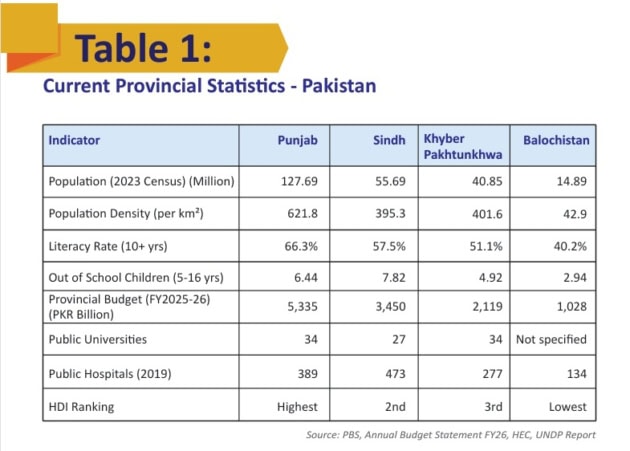A new economic study has argued that Pakistan’s oversized provinces are fueling persistent poverty and inequality, urging the government to consider splitting them into smaller administrative units.
The report, titled Economic Analysis of Provincial Restructuring in Pakistan, was published by the Economic Policy and Business Development (EPBD) think tank. It links high poverty rates and weak service delivery to Pakistan’s unusually large provinces, which the study says are global outliers in terms of population size per administrative unit.
According to the study, poverty levels vary sharply across provinces: Balochistan stands at 70 percent, Khyber Pakhtunkhwa at 48 percent, Sindh at 45 percent, and Punjab at 30 percent. Despite Punjab’s large population and massive budget, it has fewer public hospitals and universities per million people compared to smaller provinces. Sindh, meanwhile, has 7.8 million out-of-school children, highlighting inefficiencies in resource allocation.


The think tank noted that Pakistan’s average population per province is nearly 60 million, compared to just 6.6 million in the United States, 7.3 million in Indonesia, and 2.1 million in Malaysia. This, it said, creates bottlenecks in governance and hinders targeted economic policies.
Benefits of Provincial Restructuring
The analysis suggests that smaller provinces would:
- Enable more targeted infrastructure spending, creating jobs and boosting private investment.
- Improve fund utilization by making budgets more accountable and region-specific.
- Reduce income disparities by developing policies based on local strengths and comparative advantages.
- Support industrial growth and human capital development through better alignment of education and labor market needs.
The report outlines three restructuring scenarios: a 12-province structure with 20 million people per unit, an expanded setup of 15–20 provinces averaging 12–16 million, and a direct federal-division model with 38 units averaging 6.3 million people.
Scenario 1: 12-Province Structure
“Under a 12-province structure, federal transfers would continue to follow the 7th NFC award formula. The average total provincial budget would be approximately Rs994 billion per province, which is a reduction from the current average of Rs2,983 billion. However, this reduction is expected to be offset by significant improvements in fund utilization efficiency and development effectiveness. Each province would manage approximately 20.1 million people, down from the current average of 59.8 million. This would enable more responsive governance and targeted development strategies.”
Scenario 2: Expanded Provincial Structure (15-20 Provinces)
“Creating 15-20 provinces would maximize administrative responsiveness while maintaining viable economic development capacity. The average total provincial budget would be approximately Rs600-800 billion per province, with each province managing 12-16 million people, creating optimal conditions for targeted development interventions and accountability. This structure would particularly benefit Pakistan’s diverse ethnic and linguistic communities by providing dedicated administrative units aligned with cultural and economic identities.”
Scenario 3: Direct Federal-Division Structure (38 Divisions)
“Direct federal management of 38 divisions represents an alternative approach that could capture administrative efficiency benefits while maintaining centralized coordination capacity for large-scale economic development initiatives. Each division would manage approximately 6.3 million people, enabling highly targeted development interventions. The federal-division structure would facilitate coordinated economic planning across regions while maintaining local implementation capacity.”
To support new provinces, the study recommends reforms in agricultural income tax, land and property taxation, and urban real estate levies. Collectively, these could generate up to 3% of GDP in additional provincial revenue.
The EPBD report concludes that, under effective governance, provincial restructuring could become a “strategic path to sustainable and inclusive economic growth.”
